Todays SHP comes to you from the City of Mainz , a little West of Frankfurt , Germany.
Thomas
Livingstone-
Learmonth (1783-1869), a strict Presbyterian, was a merchant in Edinburgh, Scotland then a comptroller of customs at Grangemouth before heading off to the West Indies making a great deal of money in the service of the British East India Company as a merchant in Calcutta. In 1835 he was a merchant in
Hobart Town, Tasmania and at the time his four sons were
John aged 23, Thomas Jnr. aged 17, Somerville aged 16 and Andrew aged 10. Thomas and Somerville were still in their teens when they were sent over by their father to Victoria to find suitable farming land for sheep. They were leaders in the pastoral settlement of what was then known as Port Phillip first settling at the head of the Barwon River, Geelong, and then at Buninyong followed by Burrumbeet in 1838 passing over the site of present day
Ballarat. Settlers were afraid to penetrate in to the interior in order to take up runs as aborigines were committing depredations within 15
miles of Geelong. Early maps show that the ‘Run’ extended in 1848 to Mount Beckworth in the North East, the head of Mount Emu Creek in the West and below Lake Burrumbeet in the South. There were drought conditions in the 1830’s and 1840’s and that surely influenced their decision to acquire the Ercildoun Run, now over 73,000 acres in size, with its excellent flowing springs at the foot of Mount Ercildoun. They erected a
home and woolshed at Buninyong but the discovery of gold at Buninyong may have influenced them to shift farther out to Ercildoun as they were men of strong character and principle. They even moved the exceptional
shearing shed by wagon to Ercildoun having painted numbers on every joint. In 1849 Ercildoun was licensed as 45,000 acres in size in the names of
John, Thomas Junior and Somerville. Sir Alan Currie in his notes states that the house was started in 1840 and additions added until finally completed in 1858.
In the 1850’s the Learmonths paid £75,000 for 20,000 acres and Ercildoun became one of the more famous stately properties in rural Victoria with the
Learmonth Brothers noted for their hospitality and charitable work. The
homestead developed in to something of a village with its own school and gaol. Boundaries between the ‘runs’ existed only as natural features or as ploughed furrows. In 1852 in a letter from Andrew
Learmonth to Lieut. Governor
Latrobe, he states that the buildings upon the ‘run’ at Burrumbeet are dispersed over 3 overseen stations. In around 1859 major building works took place and
the brothers completed their Scottish baronial
homestead with gabled wings and crow stepped and castellated parapets, built out of
granite hewn from the slopes of Mount Ercildoun and bricks that were handmade in a kiln on the property. It is believed that they brought with them 64 men and their families and before the
homestead was started, 22 houses were built on the property for them. Only a couple of these buildings remain today with a few chimneys remaining as evidence where some of the houses once stood.
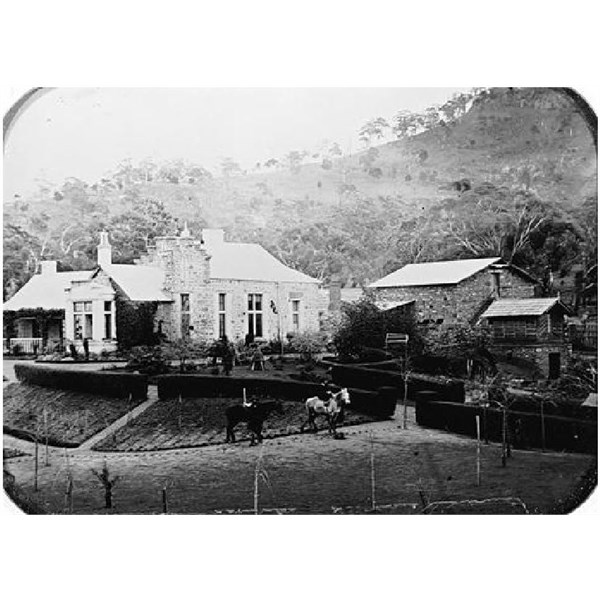
Ercildoune Homestead around 1875
An amazing and illuminating Journal kept by Thomas and Somerville, written in 1851 when they sailed from
Melbourne to London gives a strong indication of their amazing depth of character. It attributes their prosperity by mentioning two specific things being that so many of the other members of their family were there with them, and that they had more than the usual share of difficulty to contend with. It mentions also that during their last 16 years that they had seen many vicissitudes including the depth of adversity in 1843-1845 and now unlooked for prosperity. He goes on to say: “We began to push our own fortune in 1837 at Port Phillip with a flock of 3000 sheep, when the country and only been settled by a few enterprising men from Van Diemen’s Land and the stations not extending more than 30
miles from the coast, and that in only 2 or 3 instances, and now we leave it in a prosperous colony, about to the separated from the elder colony of New South Wales, with upwards of 6,000,000 sheep, 1,200,000 horned cattle and a revenue of £200,000 a year.” They also mention the good hand of God upon them, guiding and directing them and causing all things to work together for their good, plus how important it is for a
young man to know that a father and mother’s eye is upon him, warning him and encouraging him. It is incredible that he says that he was wholly unable to cope with the superior talent and energy of his coevals in the Old Country but that he was able to prosper in Australia as a field is opened up even for inferior talent, common industry and perseverance being sufficient to raise anyone (even the illiterate) to a competency or even affluence. Ercildoune Station became one of the greatest sheep studs in Australia as they went about purchasing and selectively breeding sheep in a way that has been instrumental in shaping the Australian merino. It was also formed on the famous Furlonge blood, pure Saxony merinos that were driven by an absolutely amazing woman Mrs. Eliza Furlonge and her sons, across Europe, brought to England and then to Tasmania in about 1829. Thomas Shaw, a famous wool classer, also played a major role in giving advice that influenced their sheep breeding program. The Learmonths even built and designed their own sheep washing apparatus and their washed merino fleece was described in the London Universal Wool Exhibition as ‘absolute perfection, the handsomest bale of wool we ever saw’. They chartered a ship and brought over the first herd of short-horned cattle to these shores. They also established fish hatcheries on the property and played a large part in the successful introduction of Murray Cod in to Lake Burrumbeet in 1858 and from 1870-73 raised trout on behalf of the
Ballarat Fish Acclimatization Society. They were also outstanding gardeners and created an amazing network of paths and highly cultivated garden beds having brought out trees in pots from Scotland including oaks, elms, poplars, chestnuts and plane trees. They were leaders in the use of machinery with threshing and winnowing machines and a flour mill where water was used to power the mill which ground their wheat into flour.
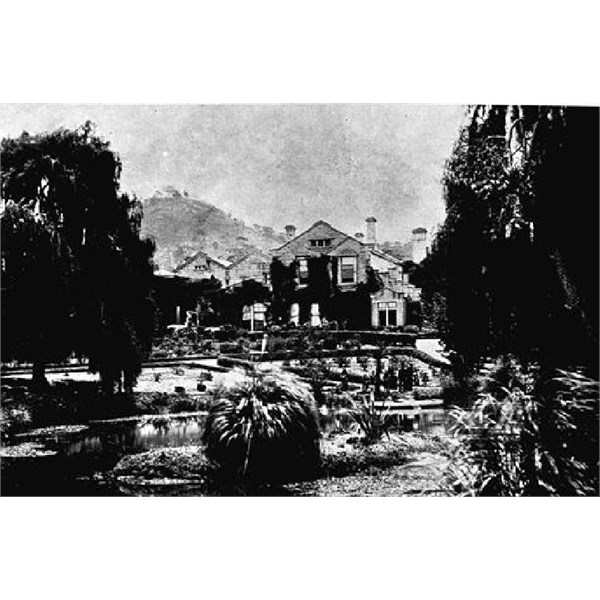
Ercildoune Homestead, Ballarat, Victoria, 1879
They met the many challenges head on including the lack of suitable employees, droughts, attacks by aborigines and bushrangers with Ercildoun having been held up by Gowrie in 1872. Thomas eventually married and sadly a daughter died at only a few weeks of age in 1858 and she is buried in the Ercildoun
Cemetery that closed for interments in 1895. Thomas went on to have four sons and three daughters here at Ercildoun and Somerville, three sons and two daughters. But it was when they became involved in gold that their patience was tested. They had some success to start with but then sold their share in the Mount Egerton Gold
Mine to a man that had been their Manager and in a short time huge amounts of gold was discovered. They went to Court but lost and this cost them a great deal of money as
well. Feeling that justice had not been served possibly helped influence them to return to their homeland, although all of Thomas
Learmonth Senior’s sons left descendants and all returned to Britain before or soon after his death. Andrew apparently said that he was intending to return
home because “of the hopeless exclusion of the upper classes from public life in Australia and the envy which they had to contend with.” Thomas is buried in the family lair at Warriston
Cemetery, Edinburgh. Other members of their family continued their interest in pastoral properties in New South Wales and Queensland
well in to the 20th century including the 310,000 acre ‘Groongal’ on the
Murrumbidgee River, New South Wales. They were also members of the exclusive
Melbourne Club that was established after a gathering of 23 Victorian squatters and businessmen in 1838, the same year that was chiselled in to the lintel over the front door of Ercildoune.
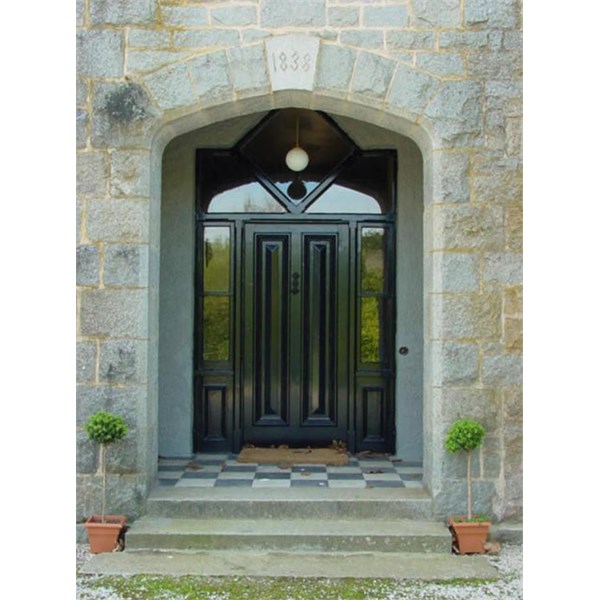
The main door with the 1838 keystone
In 1873 they sold the Station consisting of 26,823 acres carrying 26,000 sheep to the Irish born Sir Samuel
Wilson for £236,000 on a walk-in walk-out basis and it was stated that no woolgrower had better sheep than T. & S.
Learmonth. There is a town, a lake and also a road in
Ballarat named after them.
Sir Samuel had arrived in Australia in 1852 aged 20 years with his brother
John. They had been given £1,000 each to help them get started. He had been involved in the manufacture of linen and farming back in Ireland and tried his hand at gold mining with some success before prospering as a carrier of supplies to the diggings. He, like the Learmonths, didn’t like the rough life of a mining town and soon invested his capital in a station property with his brothers,
John and Charles, buying Longerenong, 153,000 acres in size for £40,000. He created an irrigation system that became the forerunner of today’s Mallee-Wimmera water gravitation scheme. He married Jeannie the daughter of one of Australia’s richest pastoralists, William Campbell in 1861. Their first child is buried in the Longerenong family
cemetery. Sir Samuel
Wilson’s achievements are many. By 1879 he held 117,452 acres freehold in Victoria, 150,000 acres freehold in New South Wales as
well as 2,500,000 acres under lease in New South Wales and Queensland and at one stage owned 600,000 sheep, possibly more than any one else at this time in the world. He was described as living a lifestyle similar to an ‘opulent country gentleman in England’ with an estimated annual income of £100,000. He was a member of the Acclimatization Society that actively introduced English plants and animals to Australian shores to make it more like ‘
home’. He wrote a book called ‘Salmon at the Antipodes’ and pamphlets on the Angora goat, the ostrich and the Chinese yam! He established a Sambar deer park on Mount Ercildoune and released chital deer in to the Wimmera in the 1860’s from his Longerenong property. At Longerenong he tried camel breeding and also helped acclimatize the camels used in the unfortunate Burke and Wills expedition. He too became embroiled in a Court Case when his sons’ gift of a 2000 year old marble Palestinian wellhead apparently upset the authorities who ordered him to pay £64,000 for venturing on to consecrated ground or return the wellhead. He paid and it now is a focal point of the garden.
With the assistance of Thomas Shaw’s son Jonathan, he improved the Merino flock even further with the breeding of a more robust type with a larger carcase, and longer, stronger wool, with a heavier fleece and better coverage. He too won numerous prizes in London and in Paris won the only Gold Medal given for Victorian Wool. Ercildoune Rams sold between 100-500 guineas each during his time here holding famous Merino Sales of 1878-1880. He also kept the pedigreed Hereford herd in its original purity.
Sir Samuel also added the letter ‘e’ to Ercildoune because he wanted an even number of letters on his gates! The garden was extended to 40 acres and the impressive 1 mile long carriage way planted out with trees. He built a 1 acre 10’ high walled garden modelled on similar gardens in England for the cultivation of tender plants and vegetables and it is the only example in Victoria and probably unique in Australia. He had built a massive glass curvilinear conservatory that unfortunately is no longer in existence. We’re not sure if he added on the back wing but believe that he built the Gothic style Manager’s House above the lake. He liked the Gothic Style and this was in evidence in the Hall built for
Melbourne University with his generous bequest of £30,000 in 1874. Sadly this was destroyed in a fire in 1952 after a fire started in the roof. At the height of his residency there were 125 people employed here including 13 gardeners. He was a keen sportsman and coursing events were held regularly in the paddocks opposite the front
gate although fishing was probably his main recreational interest.
He had four sons and three daughters. One son married Sir Winston Churchill’s aunt and one daughter married the Earl of Huntingdon. A son was killed in the South African War and another badly and permanently wounded. Two other sons died in the Great War.
He also assisted his nephew Sir Samuel McCaughey who also became a very successful pastoralist owning or sharing in 12 properties in New South Wales and Queensland totalling 3,250,000 acres. On his amazing property called ‘Coornong’, 500,000 sheep were shorn in one year. He even consulted with Louis Pasteur about the rabbit problem.
Dame Nellie Melba leased Ercildoune in 1907 and had a tennis court built for her use.
Major Alan Currie, of Scottish
heritage, bought Ercildoune now 8,000 acres for the reputed sum of £100,000 in 1920. His father owned the famous property called ‘Larra’ near Skipton and was a great rival of the
Learmonth brothers with the prize listing often reading
Learmonth first and Currie second and vice versa. His rams were also in great demand even overseas. In his University days Sir Alan had been a gunner in the volunteer Rupertswood battery of horse artillery founded by Sir William Clarke and he was awarded the Military Cross in 1918 and was demobilised with the rank of Major in 1920.
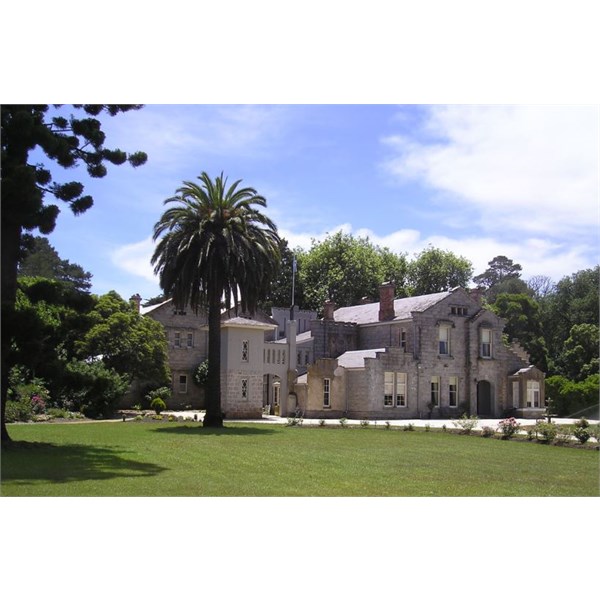
Ercildoune Homestead more recent
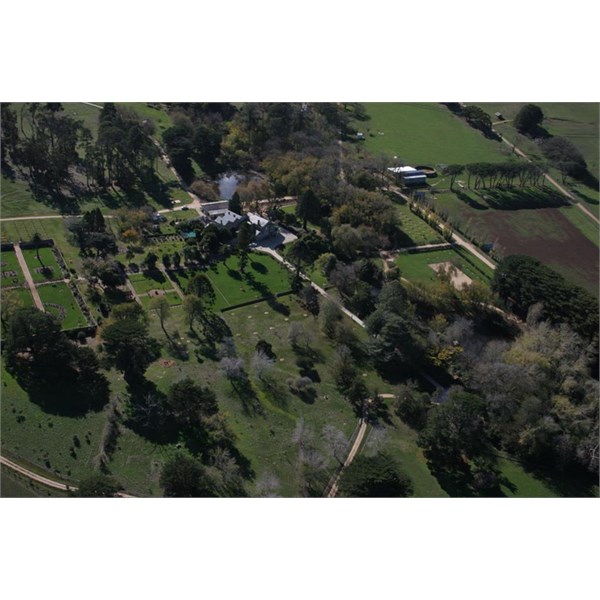
An aerial view of Ercildoune Homestead
Sir Alan continued on the fine wool merino Stud based on the original
Camden Park strain, as his father’s Larra merinos had also been. He was interested in hydro-electricity and was involved in the hydro-electricity scheme in 1896 which supplied water to the Kalgoorlie goldfields from a catchment near
Perth about 340
miles away and which is still in evidence today. He implemented a scheme here to provide electricity to the
homestead via a holding tank and channels emanating from Bishop’s
Dam that worked perfectly until a sheep ended upside down in a channel blacking out the
homestead from time to time.
In 1934 Ercildoune was visited by the King’s son, H.R.H. Prince Henry, the Duke of
Gloucester. The Visitors’ Book also lists other famous visitors including Robert
Menzies.
His interests were horses both for racing and polo and his polo ponies were also exported to India. He won the Newmarket Handicap but also bred some good jumpers who won the Grand National Steeplechase and Grand National Hurdle. In 1901 he was elected to the V.A.T.C. and became Chairman the following year. He became Chairman of the V.R.C. in 1935. He received his knighthood in 1937 in recognition of his service to the community. His death in 1942 brought about the closure of the historic trout and salmon hatchery, although Lady Currie continued on here until her death in 1962. They didn’t have any children and their magnificent 18th and 19th century furniture, with some pieces even being from the
Learmonth era, and notable art collection was gifted by Lady Muriel Currie in memory of her late husband to the
Ballarat Fine
Art Gallery.
The garden and designed landscape is an outstanding example of the picturesque landscape style and one of Victoria’s most important properties containing a significant collection of buildings and garden structures, landscape features and trees. It is a truly unique property and the atmosphere of the Scottish Border seems to have been transplanted to Australia.
So much easier with a good internet connection, next week will be from
Orange NSW.
.